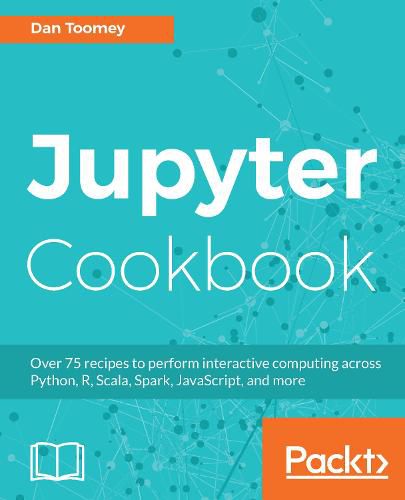Readings Newsletter
Become a Readings Member to make your shopping experience even easier.
Sign in or sign up for free!
You’re not far away from qualifying for FREE standard shipping within Australia
You’ve qualified for FREE standard shipping within Australia
The cart is loading…






This title is printed to order. This book may have been self-published. If so, we cannot guarantee the quality of the content. In the main most books will have gone through the editing process however some may not. We therefore suggest that you be aware of this before ordering this book. If in doubt check either the author or publisher’s details as we are unable to accept any returns unless they are faulty. Please contact us if you have any questions.
Leverage the power of the popular Jupyter notebooks to simplify your data science tasks without any hassle
Key Features
Create and share interactive documents with live code, text and visualizations Integrate popular programming languages such as Python, R, Julia, Scala with Jupyter Develop your widgets and interactive dashboards with these innovative recipes
Book DescriptionJupyter has garnered a strong interest in the data science community of late, as it makes common data processing and analysis tasks much simpler. This book is for data science professionals who want to master various tasks related to Jupyter to create efficient, easy-to-share, scientific applications.
The book starts with recipes on installing and running the Jupyter Notebook system on various platforms and configuring the various packages that can be used with it. You will then see how you can implement different programming languages and frameworks, such as Python, R, Julia, JavaScript, Scala, and Spark on your Jupyter Notebook. This book contains intuitive recipes on building interactive widgets to manipulate and visualize data in real time, sharing your code, creating a multi-user environment, and organizing your notebook. You will then get hands-on experience with Jupyter Labs, microservices, and deploying them on the web.
By the end of this book, you will have taken your knowledge of Jupyter to the next level to perform all key tasks associated with it.
What you will learn
Install Jupyter and configure engines for Python, R, Scala and more Access and retrieve data on Jupyter Notebooks Create interactive visualizations and dashboards for different scenarios Convert and share your dynamic codes using HTML, JavaScript, Docker, and more Create custom user data interactions using various Jupyter widgets Manage user authentication and file permissions Interact with Big Data to perform numerical computing and statistical modeling Get familiar with Jupyter’s next-gen user interface - JupyterLab
Who this book is forThis cookbook is for data science professionals, developers, technical data analysts, and programmers who want to execute technical coding, visualize output, and do scientific computing in one tool. Prior understanding of data science concepts will be helpful, but not mandatory, to use this book.
$9.00 standard shipping within Australia
FREE standard shipping within Australia for orders over $100.00
Express & International shipping calculated at checkout
This title is printed to order. This book may have been self-published. If so, we cannot guarantee the quality of the content. In the main most books will have gone through the editing process however some may not. We therefore suggest that you be aware of this before ordering this book. If in doubt check either the author or publisher’s details as we are unable to accept any returns unless they are faulty. Please contact us if you have any questions.
Leverage the power of the popular Jupyter notebooks to simplify your data science tasks without any hassle
Key Features
Create and share interactive documents with live code, text and visualizations Integrate popular programming languages such as Python, R, Julia, Scala with Jupyter Develop your widgets and interactive dashboards with these innovative recipes
Book DescriptionJupyter has garnered a strong interest in the data science community of late, as it makes common data processing and analysis tasks much simpler. This book is for data science professionals who want to master various tasks related to Jupyter to create efficient, easy-to-share, scientific applications.
The book starts with recipes on installing and running the Jupyter Notebook system on various platforms and configuring the various packages that can be used with it. You will then see how you can implement different programming languages and frameworks, such as Python, R, Julia, JavaScript, Scala, and Spark on your Jupyter Notebook. This book contains intuitive recipes on building interactive widgets to manipulate and visualize data in real time, sharing your code, creating a multi-user environment, and organizing your notebook. You will then get hands-on experience with Jupyter Labs, microservices, and deploying them on the web.
By the end of this book, you will have taken your knowledge of Jupyter to the next level to perform all key tasks associated with it.
What you will learn
Install Jupyter and configure engines for Python, R, Scala and more Access and retrieve data on Jupyter Notebooks Create interactive visualizations and dashboards for different scenarios Convert and share your dynamic codes using HTML, JavaScript, Docker, and more Create custom user data interactions using various Jupyter widgets Manage user authentication and file permissions Interact with Big Data to perform numerical computing and statistical modeling Get familiar with Jupyter’s next-gen user interface - JupyterLab
Who this book is forThis cookbook is for data science professionals, developers, technical data analysts, and programmers who want to execute technical coding, visualize output, and do scientific computing in one tool. Prior understanding of data science concepts will be helpful, but not mandatory, to use this book.